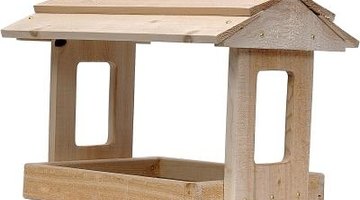The Differences Between Hummingbird & Oriole Feeders
If you've recently decided to create a backyard habitat to attract birds, then your head may be spinning with all the different types of bird feeders available. Hummingbird and oriole feeders may look similar, but they are designed differently. Also, since orioles have diverse tastes, there are several different types of oriole feeders available. Understanding the differences among them can help you make the right decision as to which one to place in your yard.
Major Differences


Hummingbird and oriole feeders are both considered nectar feeders because they simulate flower nectar that these birds like to eat. In general, hummingbird feeders are red and have smaller holes and perches. Oriole feeders are orange with larger perches. Both can be filled with the same type of nectar.
Other Types of Oriole Feeders

There are a number of different types of oriole feeders available. Some are designed like hummingbird feeders to feed orioles nectar (sugar water). Oriole feeders can also be designed to feed orioles fruit, jelly, suet cakes as well as sugar water. Some feeders may combine several of these features into one feeder. Orioles love grape or apple jelly, orange marmalade, oranges and berries.
How to Make Nectar
Hummingbird and oriole nectar is made the same way. Add one part sugar to four parts boiling water. Stir until the sugar is totally dissolved. Wait for the water to cool before using it. Do not add food coloring as it is potentially harmful for the birds. Change nectar every three to five days to prevent mold and fermentation. Do not use honey or artificial sweeteners when making nectar. Store extra nectar in the refrigerator until ready to use.
When to Use Nectar Feeders

For the most part, orioles and hummingbirds are migratory birds, so nectar feeders only need to be used during the spring, summer and fall. Some southern and western states may have hummingbirds year round. Place your nectar feeders out in March or April (earlier in the south, later in the north). Keep them out until about two weeks after you last see birds feeding at them.
References
Resources
Writer Bio
Darcy Logan has been a full-time writer since 2004. Before writing, she worked for several years as an English and special education teacher. Logan published her first book, "The Secret of Success is Not a Secret," and several education workbooks under the name Darcy Andries. She received her Bachelor of Arts in English and Master of Arts in special education from Middle Tennessee State University.
Photo Credits
- Jupiterimages/Photos.com/Getty Images
- Dynamic Graphics Group/Dynamic Graphics Group/Getty Images
- Zedcor Wholly Owned/PhotoObjects.net/Getty Images
- NA/Photos.com/Getty Images
More Articles



